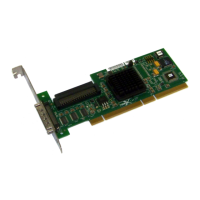Ultra320 SCSI Host Adapters User’s Guide A-1
Version 2.3 Copyright © 2002–2004, 2006 by LSI Logic Corporation. All rights reserved.
Appendix A
Glossary of Terms
Active
Termination
The electrical connection required at each end of the SCSI bus,
composed of active voltage regulation and a set of termination resistors.
Ultra SCSI, Ultra2 SCSI, Ultra160 SCSI, and Ultra320 SCSI require
active termination.
BIOS Basic Input/Output System. Software that provides basic read/write
capability. Usually kept as firmware (ROM-based). The system BIOS on
the mainboard of a computer boots and controls the system. The SCSI
BIOS on the host adapter acts as an extension of the system BIOS.
Configuration Refers to the way a computer is set up; the combined hardware
components (computer, monitor, keyboard, and peripheral devices) that
make up a computer system; or the software settings that allow the
hardware components to communicate with each other.
Device Driver A program that allows a microprocessor (through the operating system)
to direct the operation of a peripheral device, such as a disk drive.
Domain
Validation
A software procedure in which a host queries a device to determine its
ability to communicate at the negotiated data rate.
EEPROM Electronically Erasable Programmable Read Only Memory. A memory
chip that typically stores configuration information.
External SCSI
Device
A SCSI device installed outside the computer cabinet. These devices are
connected together using specific types of shielded cables.
Fusion-MPT
Architecture
Fusion-MPT (Message Passing Technology) architecture consists of
several main elements: Fusion-MPT firmware, the Fibre Channel and
SCSI hardware, and the operating system level drivers that support these
architectures. Fusion-MPT architecture offers a single binary, operating
system driver that supports both Fibre Channel and SCSI devices.

